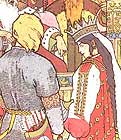


Sixty Folk-Tales From Exclusively Slavonic Sources by A. H. Wratislaw
Preface
Bohemian
Stories
Introduction
I. Long, Broad,
and Sharpsight
II. 'The Three Golden
Hairs of Grandfather Allknow'
III. Goldenhair
IV. Intelligence
and Luck
V. The Jezinkas
VI. The Wood-Lady
VII. George with the
Goat
Moravian
Stories
Introduction
VIII. Godmother Death
IX. The Four Brothers
Hungarian-Slovenish
Stories
Introduction
X. The Three Lemons
XI. The Sun-Horse
XII. The Golden
Spinster
XIII. Are You Angry?
Upper
and Lower Lusatian Stories
Introduction
XIV. Right Always
Remains Right
XV. Little Red Hood
Kashubian
Story
Introduction
XVI. Cudgel, Bestir
Yourself!
Polish
Stories
Introduction
XVII. Prince Unexpected
XVIII. The Spirit
of a Buried Man
XIX. The Pale Maiden
XX. The Plague-Swarm
White
Russian Stories
Introduction
XXI. The Frost, The
Sun, and the Wind
XII. Little Rolling-Pea
XXIII. The Wonderful
Boys
Little
Russian Stories (from Galicia)
Introduction
XXIV. God Knows How to
Punish Man
XXV. The Good Children
XXVI. The Devil and
the Gipsy
XXVII. God and the Devil
Little
Russian Stories (from South Russia)
Introduction
XXVIII. The Beautiful
Damsel and the Wicked Old Woman
XXIX. The Snake and
the Princess
XXX.
Transformation into a Nightingale and a Cuckoo
XXXI. Transmigration
of the Soul
XXXII. The Wizard
Great
Russian Stories
Introduction
XXXIII. The Lime-Tree
XXXIV. Ilya of Murom
and Nightingale the Robber
Bulgarian
Stories
Introduction
XXXV. The Lord God as
an Old Man
XXXVI. Bulgarian
Hospitality
XXXVII. Cinderella
XXXVIII. The Golden
Apples and the Nine Peahens
XXXIX. The Language
of Animals
Serbian
Stories
Introduction
XL. The Lame Fox
XLI. The Sons' Oath to
Their Dying Father
XLII. The Wonderful
Hair
XLIII. The Dragon
and the Prince
XLIV. Fate
Serbian
Stories From Bosnia
Introduction
XLV. The Birdcatcher
XLVI. The Two Brothers
Serbian
Stories From Carniola
Introduction
XLVII. The Origin of
Man
XLVIII. God's Cock
XLIX. Kurent the Preserver
L. Kurent and Man
LI. The Hundred-Leaved
Rose
Croatian
Stories
Introduction
LII. Kraljevitch
Marko
LIII. The Daughter
of the King of the Vilas
LIV. The Wonder-Working
Lock
LV. The She-Wolf
LVI. Milutin
Illyrian-Slovenish
Stories
Introduction
LVII. The Friendship
of a Vila and of the Months
LVIII. The Fisherman's
Son
LIX. The White Snake
LX. The Vila
Preface
SO much interest has lately been awakened in, and centred round, Folk-lore, that it needs no apology to lay before the British reader additional information upon the subject. Interesting enough in itself, it has been rendered doubly interesting by the rise and progress of the new science of Comparative Mythology, which has already yielded considerable results, and promises to yield results of still greater magnitude, when all the data requisite for a full and complete induction have been brought under the ken of the inquirer. The stories of most European races have been laid under contribution, but those of the Slavonians have, as yet, been only partially examined. Circumstances have enabled me to make a considerable addition to what is as yet known of Slavonic Folk-lore, although I cannot make any pretence to having exhausted the mine, or, rather, the many mines, which the various Slavonic races and tribes possess, and which still, more or less, await the advent of competent explorers.
In offering to the public a selection of sixty folk-lore stories translated from exclusively Slavonic sources, it is but fitting to give some account of the work from which I have derived them. In 1865, the late K. J. Erben, the celebrated Archivarius of the old town of Prague, published a Citanka, or reading-book, intended to enable Bohemians to commence the study of all the numerous Slavonic dialects, containing one hundred simple national tales and stories, in their original dialects. To this he appended a vocabulary, with explanations of words and forms strange to, or divergent from, the Bohemian, briefly given in the Bohemian language. This vocabulary is divided into two parts, one illustrating the tales of those Slavonians who make use of the Cyrillic characters, and belong to the Orthodox Greek Church; and the other, those of the Catholic and Protestant Slavonians, who employ alphabets founded on the Latin characters of the West of Europe. Pan Erben paid special attention to the preservation of the simple national forms of speech, as taken down from the lips of the people; and, besides laying printed collections under contribution, obtained several previously unpublished stories.
Beginning with his native tongue, the Bohemian language, he passes on to the closely-allied Moravian and Hungarian-Slovenish (Slovak) dialects, and then takes the Upper and Lower Lusatian, the former of which is related to the old Bohemian, while the latter inclines rather to the Polish language. He next goes on to the Kashubian, a rapidly-perishing sub-dialect of Polish, and then to the Polish tongue itself.
Next comes the White Russian, forming a transition from Polish to Great Russian, whereas the Little Russian in Galicia, the Ukraine, and South Russia, is more nearly allied to the Bohemian than to the White Russian. The ancient Russian language, which was also much allied to the Old Bohemian, is the basis of the present written Russian, and presents a transition to the Bulgarian, which, in the north-west, melts into the Serbian, which again, in its Croatian branch, near Varazdin, approaches most nearly to the Bohemian. The Illyrian-Slovenish of Carinthia, though, in locality, least distant from Bohemia, exhibits forms most removed from the Bohemian language, just as the Upper Lusatian is less allied to the Bohemian than is the locally-distant Kashubian.
I took up the book, originally, for the purpose for which it was compiled, viz., that of obtaining an acquaintance with the main features of all the Slavonic dialects, but found myself tempted, by the extreme beauty of some of the stories, to translate the major portion of them. That I do not present a still larger selection to the reader is due to the fact that so many of the Great Russian skazkas have been so admirably translated, edited, and illustrated by my friend--alas! that I must now term him my late friend--Mr. W. R. S. Ralston, that I have scarcely considered them as coming within the sphere of the present work.
For an essay on the singular mythical being, Kurent, occurring only in the Serbian tales from Carniola, and as yet unnoticed in any work on Slavonic mythology, I am indebted to Professor Gregor Krek, of Grätz, in Styria. This will be found prefixed to the stories which it illustrates.
I have also prefixed a short introduction, containing various matters of interest, to each set of tales, as they follow each other, according to their different languages, dialects, or sub-dialects.
The table of contents immediately following will give a general view of the stories and their respective sources, arranged under the three heads of: (a) The Western Slavonians, (b) the Eastern Slavonians, and (c) the Southern Slavonians.
The text came from:
Wratislaw, A. H. Sixty Folk-Tales From Exclusively Slavonic Sources. Boston: Houghton, Mifflin, & Company, 1890.

©Heidi
Anne Heiner, SurLaLune Fairy Tales
E-mail: surlalune@aol.com
Page last updated September 18, 2006
www.surlalunefairytales.com



